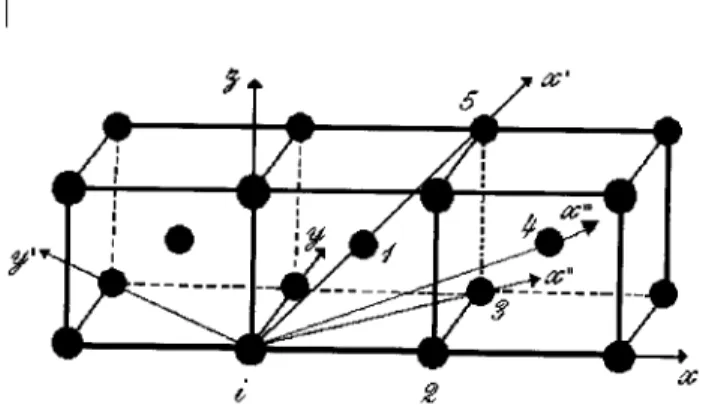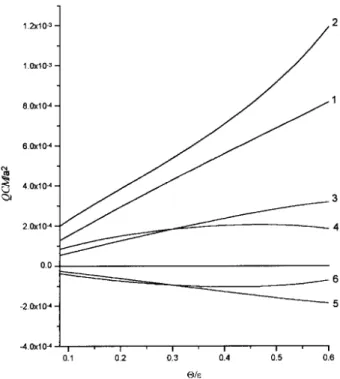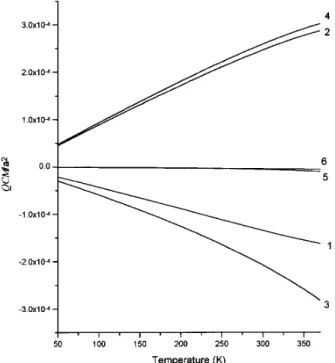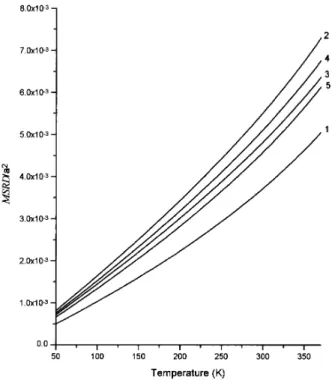Inuence of Strong Anharmonicity on the Dynamical
Properties of a Crystal with BCC Lattice
C. G.Ro drigues 1
,M. F.Pascual 1
and V. I.Zub ov 1;2 1Instituto de Fisica,
Universidade Federal de Goias, C.P. 131, 74001-970 Goi^ania-GO, Brazil 2Department of Theoretical Physics, People's Friendship University, Moscow, Russia
Received 10 December 1998
The correlative method of unsymmetrized self-consistent eld (CUSF) is used to study dynamical characteristics of a strongly anharmonic crystal with body-centered cubic lattice, namely, the inter-atomic and mean square relative displacements. We present the general formulae for crystals with anharmonicity, including the strong one, up to fourth anharmonic terms. Taking into account the second order of the method we calculate correlations in this lattice between the nearest, second, third, fourth and fth neighbors. The inuence of more distant interactions is discussed. The results are compared with those obtained previously for an weakly anharmonic BCC crystal. We use the Schi potencial forNaand also Lennard-Jones potentials for comparison.
I Introduction
The quadratic correlation moments of atomic positions (QCM) as well as their mean square relative displace-ments (MSRD) expressing the eective amplitude of the atomic vibrations are the most important features of lattice dynamics [1, 2].
Using the dynamical theory of crystal lattice, QCM and MSRD have been calculated in the harmonic ap-proximation [2]. However, this apap-proximation is not more valid at high temperatures due to anharmonic eects which are of considerable importance. Here the correlative method of unsymmetrized self-consistent eld (CUSF) [3, 4, 5, 6, 7, 8] is used to study the in-uence of anharmonic eects on the QCM and MSRD
[9, 10], including strongly anharmonic ones. The gen-eral expressions for QCM and MSRD are presented tak-ing into account anharmonic terms up to the fourth order. Recently, they have been applied to weakly an-harmonic crystal with face- and body centered cubic lattices [11, 12] and also to strongly anharmonic FCC crystal [13]. In the present paper we study a strongly anharmonic BCC crystal, namely solidNa.
II General Relations
In CUSF, the mean square relative displacements be-tween two atoms i and j in a crystal, can be written as
c
D aa(
ij) = (q ia
,q ja)
2 =q
2 ia+
q 2 ja
,2C aa(
ij); (1)
where a denotes the Cartesian components of atomic displacements and C aa(
ij) = q ia
q
ja is the correlation mo-ment.We consider a perfect crystal with pairwise central interactions
U(~r;:::;~r N) = 12
X i6=j
(j~r i
,~r j
In this case, taking into account anharmonic terms up to the fourth order we have for variances of the atomic positions [10] q 2 ia = a 2 i 0
+ 122 X k f ( ik) ( ik) k k 0 (a 2 i i i 0 ,a 2 i 0 i i
0) + +14 (ik)
"( ik)[ k k 0 (a 2 i i i i " i 0 ,a 2 i 0 i i i " i 0 ), ,2 i " i 0 k k 0 (a 2 i i i 0 ,a 2 i 0 i i 0 ) + +(a 2 i i i 0 ,a 2 i 0 i i 0 )( k k " k k 0 , k k 0 " k k 0 )] + +13(
ik) "( ik)[ k k 0 (a 2 i i i i " i 0 ,a 2 i 0 i i i " i 0 ) + + k k " k k 0 (a 2 i i i 0 ,a 2 i 0 i i 0)]
g; (3)
and for QCM [9]
C ab(
ij) = 1 (
ij)a i i 0 b j j 0 + + 16 (ij)(a
i i i i 0 b j j 0 ,a i i 0 b j j j j 0 ) + + 12
X k
(
ik) (jk)a i i 0 b j j 0 k k 0 , , 1 42 (
ij) "(
ij)a i i i i 0 b j j " j j 0 + + 142
X k
(ik) "(
jk)a i i 0 b j j 0 ( k k " k k 0 , k k 0 " k k 0 ) + + 142 (
ij) X
k ( "(
jk)a i i 0 b j j j j 0 , "( ik)b
j j 0 a i i i i 0 ), , 1 42 ( ij) "( ij)a
i i i i 0 b j j " j j 0 + + 162
X k
(( ik)
"(
jk) + (jk) "(
ik))a i i 0 b j j 0 k k " k k 0 + + 162
X k
(( ik)
"( jk)a
i i 0 b j j j " j 0 + + (jk)
"( ik)a
i i i " i 0 b j j 0 ) k k 0 ; (4)
where =k T is the absolute temperature in energy units, and (ik) =
@:::(j~r j) @x
@x
::: j
~r = ^ A (n i ,n k ) ; (5)
are the derivatives of the interatomic potential, and all Greek indices are dummy. Generally speaking, the summation extends over allK. For a perfect strongly anharmonic crystal of a high symmetry, the moments in the right sides are expressed as [14].
q 2 0 = 3K 2 ; q 2 q 2 0
= (1 + 2 )
"
2(3,) 5K 4 , 3K 2 2 # ; (6)
where (x) is the solution of the transcendental equation
(x) = 3x D
,2:5[
x+ 5=6x] D
,1:5[
x+ 5=6x]
in which D(z) are the parabolic cylinder functions and x is dimensionless combination of the temperature and the second- and fourth-order force coecients x = K2
p 3=K2, K2= 13
3 X
=1
K2; K 4 = 35
3 X
;=1
K22; (8)
where
Klm = @l +m @qlqm
X
n6=0
(jq, ^Anj)jq
=0 : (9)
Here ^A is the lattice matrix and n are vectors with integer components. The lattice matrix can be calculated from the equation of state. For cubic crystals with strong anharmonicity up to the fourth order under hydrostatic pressure it is of the form [4, 5]
P =, a 3v
1 2dK0
da +2K2 dK2
da +(3 ,) 4K4
dK4 da
+ P2+ PH+ PQ ; (10)
where a is the nearest neighbor distance, v(a) is the volume of the unit cell and K0(a)=2 is the energy per molecule in the static lattice. Here P2 and PH are the corrections of perturbation theory, and PQ is the rst quantum correction.
d
III Inuence on the dynamical
properties of strongly
an-harmonic BCC crystal
A spatial fragment of a strongly anharmonic crystal with body centered lattice is shown in Fig. 1. First we shall consider only the nearest neighbor interactions. In this case, we can see from formula (4) that the second-order perturbation theory enables the moments to be calculated up to the fth neighbors, inclusive. For the second neighbors it is more convenient to use the crys-tallographic coordinate system. Finally, under a rota-tion of =4 around the crystallographic Z-axis, we ob-tain correlation moments between the third neighbors.
Figure 1. The arrangement of the neighbors of an atom in the BCC lattice for the spatial fragment of this lattice.
Schi [15] proposed the following potential for sodium which is a typical crystal with the BCC lattice
c '(r)=" =,
A + B=R2+ C=R4
cos(2kFR)
R3 +
,
D + E=R2
sin(2kFR)
R4 ; (11)
d where R = r=, is the depth of the potential "=k = 599K, = 0:324 nm the eective diameter of an ion screened by free electrons. The parameters are: A = 0:19, B = ,1:02, C = ,0:08, D = ,0:43, E =,2:54, 2kF = 5:987. Such potential is of an
oscil-lating form, what is known as Friedel oscillations. Es-sentially all calculations that use such potentials refer to numerical modelling [16].
solution the equation of state Eq. (10) obtained in ref-erence [17]. We make this in the dimensionless form taking into account only the nearest neighbor interac-tions.
Figure 2. Quadratic correlation moments between lon-gitudinal displacements of the nearest neighbors, C
xx(1),
calculated using various approximations: 1-harmonic, 2-weakly anharmonic, 3-strongly anharmonic, and fth neig-bors,Cxx(5): 4-harmonic, 5-weakly anharmonic, 6-strongly
anharmonic.
In Fig. 2 are plotted the correlations of longitudi-nal displacements between the nearest and fth neigh-bors versusthe dimensionless temperature ="for the strongly anharmonic approximation using the Schi for Na potential, as well as the harmonic and weakly an-harmonic approximations [12]. Note that at high tem-peratures the anharmonicity reverses the convexity of the curve C
xx(1) and C
xx(5) for the strongly anhar-monic approximation. Moreover for this approximation C
xx(1) becomes greater and C
xx(5) less than the one for the weak anharmonicity.
In Figs. 3 and 4 we compare the longitudinal and transversal correlation moments respectively calculated using the Lennard-Jones and Schi potentials. We can see that the correlation moments using the Schi po-tential forNaare less anharmonic and at high tempera-tures their values are also less than the ones calculated
by the Lennard-Jones potential with the exception of the curvesC
xx(5) and C
y y(1).
Figure 3. Longitudinal correlations momentsCxx(1)-(1,2), Cxx(1)-(3,4) and Cxx(2)-(5,6) calculated using the Schi
(1,3,5) and the Lenard-Jones (2,4,6) potentials.
The melting temperature ofNais 373K. For tem-perature less than 50K,Nahas another crystal struc-ture. For this reason we investigate the QCM and MSRD in the temperature range between 50 K and 373 K. In Fig. 5 we present the longitudinal and transversal correlations between the nearest, second, third and fth neighbors calculated using the Schi po-tential. One can see that some moments are negative implying that the corresponding atoms oscillate at such a direction for the most part opposite in phase. The negative sign of the longitudinal correlation moment in the second-order perturbation theory results from the obtuse angle between them and each of their common nearest neighbor. When this angle is acute, such a cor-relation is positive and in the case of straight angle, it is very small being proportional to the temperature squared. As a result of the symmetry of the coordinate systems the components of transversal correlations be-tween the nearest, second and fth neighbors are the same, namelyC
y y( n) = C
z z(
Figure 4. Transversal correlations moments C
y y(2)-(1,2), C
y y(1)-(3,4) and C
z z(3)-(5,6) calculated using the Schi
(1,3,5) and the Lenard-Jones (2,4,6) potentials.
Figure 5. Correlations moments in the BCC lattice calcu-lated using the Schi forNapotential: 1,C
xx(1), 2 ,C
xx(5),
3,C xx(3), 4
,C y y(2), 5
,C y y(5), 6
,C y y(5), 1
,C z z(3),
1,C xx(2).
IV An Inuence of the More
Distant Interactions
The interactions between more distant atoms provide the thermodynamic stability of the BCC crystal. For this reason, we shall discuss an inuence of the more distant interactions on QCM for a strongly anharmonic BCC crystal. To do this we use the solution of equation of state (10) taking into account interactions up to the seventh neighbors [17].
For the BCC lattice, the dierence between the nearest- and second-neighbor distances is about 15:5%, while that between the second- and third-neighbor ones is more than 40%. For this reason we include only the inuence of the second-neighbor interactions on the in-teratomic correlations.
Figure 6. Longitudinal correlations moments Cxx(2)-(1,3), Cxx(4)-(5) and transversalCy y(5)-(2,4),Cy y(4)-(6) without
(1,2) and with the second-neighbor interactions (3,4,5,6), calculated using the Schi forNapotential.
neigh-bors. The correlations C
xx(4) and C
y y(4) are a conse-quence of the interactions between the second neigh-bors. The correlations between the fourth neighbors are very small.
In Fig. 7 we show the mean square relative atomic displacements in the BCC crystal with strong anhar-monicity calculated using the Schi for Na potential and considering the inuence of more distant interac-tions.
Figure 7. Longitudinal mean square relative displacemets: 1,D
xx(1), 2 ,D
xx(2), 3 ,D
xx(3), 4 ,D
xx(4) 'D
xx( n), n6, 5,Dxx(5).
V Conclusions
Using CUSF we have studied the interatomic quadratic correlation moments and the mean square relative dis-placement of atoms in a BCC crystal, namely, in solid Na at normal pressure. We evaluated the harmonic, weak and strong anharmonicity. The comparisons of theses three approximationsshow the importance of the anharmonic eects at high temperature.
The fact that the transversal correlations throughY andZ -axis are much smaller than the longitudinal cor-relations through the -axis is because you have chosen the coordinate system with X -axis running through the centers of atoms.
The negative correlations are due to the moviment of their atoms that oscillate opposite in phase.
The longitudianal correlations between the nearest neighbors in BCC lattice are greater than in FCC lat-tice. However, in BCC crystal the transversal corre-lations between the second neighbors are less than in FCC lattice.
The present work completes a series of investiga-tions on interatomic correlainvestiga-tions and relative displace-ments of atoms in low-dimensional models of anhar-monic crystals [9, 10, 18] as well as in three-dimensional strongly and weakly anharmonic crystals [11, 12, 13, 19].
Finally, we used the results obtained here to study the inuence of the strong anharmonicity on Linde-mann's melting law which is a subject that has dis-played an active interest up to the present [20].
References
[1] M. Born, K. Huang,Dynamical theory of crystal lattices, Clareidon Press (1954).
[2] G. Leibfried,Gittertheorie der mechanischen und ther-mischen eigenschaften der Kristalle, Springer-Verlag, Berlin, (1955).
[3] V. I. Zubov and Ya. P. Terletsky, Ann. Phys. (Leipzip)
24, 97 (1970).
[4] V. I. Zubov, Phys. Stat. Sol.(b)72, 71, 483 (1975).
[5] V. I. Yukalov and V. I. Zubov, Fortschr. Phys.31, 627
(1983).
[6] V. I. Zubov and M. F. Pascual, Izv. Vuzov, Fizika No. 6, 67 (1984), in Russian.
[7] V. I. Zubov and J. N. Teixeira Rabelo, Phys. Rev. B49,
8671 (1994).
[8] V. I. Zubov and I. V. Mamontov, Bull. RUDN3, N. 1,
80 (1995), in Russian.
[9] V. I. Zubov, M. F. Pascual and J. N. Teixeira Rabelo, Phys. Stat. Sol. B175, 331 (1993).
[10] V. I. Zubov. M. F. Pascual, J. N. Teixeira Rabelo and A. C. Faria, Phys. Stat. Sol. B182, 315 (1994).
[11] V. I. Zubov, M. F. Pascual and C. G. Rodrigues, Mod. Phys. Lett. B10, 1043 (1996).
[12] C. G. Rodrigues, M. F. Pascual and V. I. Zubov, Brazil-ian Journal of Physics27, no. 4, 448 (1997).
[13] V. I. Zubov, C. G. Rodrigues and M. F. Pascual, Int. J. Mod. Phys.12, 2869 (1998).
[14] V. I. Zubov, I. V. Mamontov, and N. P. Tretyakov, Internat. J. Mod. Phys. B6, 221 (1992).
[16] A. E. Galashev, Teplozicheskie svoistva metastabil-nikh sistem, Academy of Sciences of USSR, 1984 (p. 35) (in Russian).
[17] V. I. Zubov, J. F. Sanchez, N. P. Tretiakov and A. A. Caparica, Phys. Stat. Sol. B200, 27 (1997).
[18] V. I. Zubov and M. F. Pascual, Mod. Phys. Lett. B8,
523 (1994); V. I. Zubov, M. F. Pascual and C. G.
Ro-drigues, Mod. Phys. Lett. B , 839 (1995); M. F. Pascual and V. I. Zubov, Mod. Phys. Lett. B9 , 1513 (1995).
[19] M. F. Pascual, A. L. Rosa and V. I. Zubov, Mod. Phys. Lett. B10, 599 (1996).



